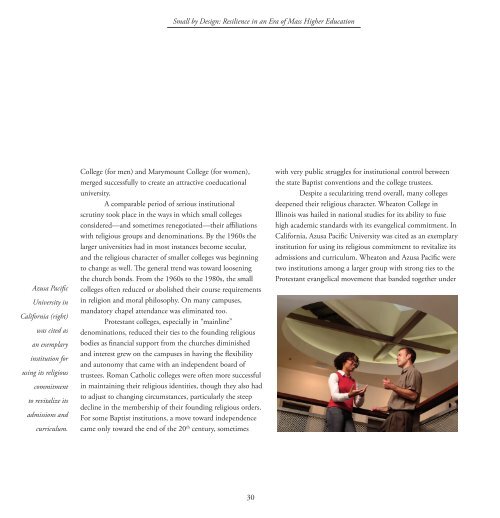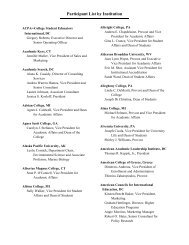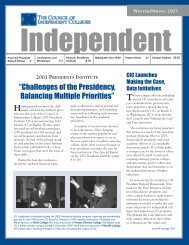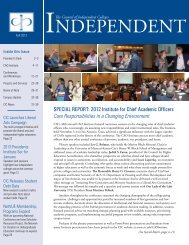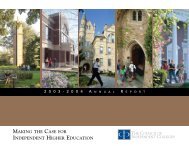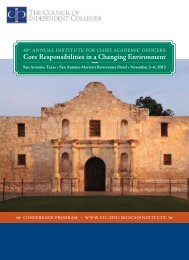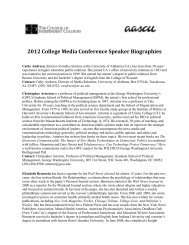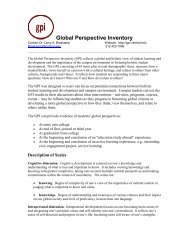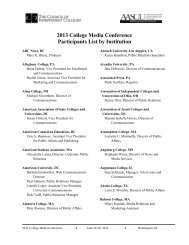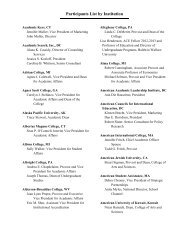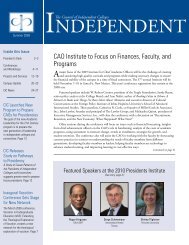Meeting the Challenge: - The Council of Independent Colleges
Meeting the Challenge: - The Council of Independent Colleges
Meeting the Challenge: - The Council of Independent Colleges
You also want an ePaper? Increase the reach of your titles
YUMPU automatically turns print PDFs into web optimized ePapers that Google loves.
Small by Design: Resilience in an Era <strong>of</strong> Mass Higher Education<br />
Azusa Pacific<br />
University in<br />
California (right)<br />
was cited as<br />
an exemplary<br />
institution for<br />
using its religious<br />
commitment<br />
to revitalize its<br />
admissions and<br />
curriculum.<br />
College (for men) and Marymount College (for women),<br />
merged successfully to create an attractive coeducational<br />
university.<br />
A comparable period <strong>of</strong> serious institutional<br />
scrutiny took place in <strong>the</strong> ways in which small colleges<br />
considered—and sometimes renegotiated—<strong>the</strong>ir affiliations<br />
with religious groups and denominations. By <strong>the</strong> 1960s <strong>the</strong><br />
larger universities had in most instances become secular,<br />
and <strong>the</strong> religious character <strong>of</strong> smaller colleges was beginning<br />
to change as well. <strong>The</strong> general trend was toward loosening<br />
<strong>the</strong> church bonds. From <strong>the</strong> 1960s to <strong>the</strong> 1980s, <strong>the</strong> small<br />
colleges <strong>of</strong>ten reduced or abolished <strong>the</strong>ir course requirements<br />
in religion and moral philosophy. On many campuses,<br />
mandatory chapel attendance was eliminated too.<br />
Protestant colleges, especially in “mainline”<br />
denominations, reduced <strong>the</strong>ir ties to <strong>the</strong> founding religious<br />
bodies as financial support from <strong>the</strong> churches diminished<br />
and interest grew on <strong>the</strong> campuses in having <strong>the</strong> flexibility<br />
and autonomy that came with an independent board <strong>of</strong><br />
trustees. Roman Catholic colleges were <strong>of</strong>ten more successful<br />
in maintaining <strong>the</strong>ir religious identities, though <strong>the</strong>y also had<br />
to adjust to changing circumstances, particularly <strong>the</strong> steep<br />
decline in <strong>the</strong> membership <strong>of</strong> <strong>the</strong>ir founding religious orders.<br />
For some Baptist institutions, a move toward independence<br />
came only toward <strong>the</strong> end <strong>of</strong> <strong>the</strong> 20 th century, sometimes<br />
with very public struggles for institutional control between<br />
<strong>the</strong> state Baptist conventions and <strong>the</strong> college trustees.<br />
Despite a secularizing trend overall, many colleges<br />
deepened <strong>the</strong>ir religious character. Wheaton College in<br />
Illinois was hailed in national studies for its ability to fuse<br />
high academic standards with its evangelical commitment. In<br />
California, Azusa Pacific University was cited as an exemplary<br />
institution for using its religious commitment to revitalize its<br />
admissions and curriculum. Wheaton and Azusa Pacific were<br />
two institutions among a larger group with strong ties to <strong>the</strong><br />
Protestant evangelical movement that banded toge<strong>the</strong>r under<br />
30


